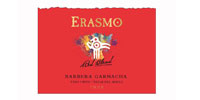|
|
 |

Erasmo, Maule Valley (Chile) Barbera (70%) Garnacha (30%) 2013 (Palm Bay International, $17): Improbably, I heard about this unusual, relatively inexpensive Chilean red during an elaborate tasting of Brunello di Montalcino, Tuscany’s luxury red wine. Count Francesco Marone Cinzano, the dapper owner of the Montalcino estate of Col d’Orcia, hosted that tasting. He mentioned in passing that he has established a wine estate in Chile and that he is blending Barbera and Garnacha. I had to try a bottle.
What intrigued me was the grape blend. I could almost taste it in my mind: Lively, spicy, edgy Barbera together with soft, round, full Grenache. It sounded to me like an inspired combination.
Barbera is a grape variety native to the Piedmont region of Italy (where Count Marone Cinzano himself traces his origins). It makes wines with high acidity and very little tannin, with flavors of blackberry and tart cherry. The Garnacha, or Grenache, grape hails from Spain and is most  known for its role in red blends from France’s southern Rhône region. It makes wines with generous alcohol levels, smooth or fleshy texture, low tannin, and red berry flavors. Both Barbera and Grenache wines vary a lot in intensity according to the crop level at which the grapes are grown; both can be simple, light-hearted wines or serious, concentrated wines. Erasmo Barbera Garnacha veers toward the concentrated style. known for its role in red blends from France’s southern Rhône region. It makes wines with generous alcohol levels, smooth or fleshy texture, low tannin, and red berry flavors. Both Barbera and Grenache wines vary a lot in intensity according to the crop level at which the grapes are grown; both can be simple, light-hearted wines or serious, concentrated wines. Erasmo Barbera Garnacha veers toward the concentrated style.
Count Marone Cinzano began his Chilean project in 1995 with consulting winemaker Maurizio Castelli, one of Italy’s most celebrated enologists. They chose the southernmost of Chile’s important wine regions, Maule Valley -- and specifically the Caliboro area in the eastern hills, whose attractions include the luminosity of clear skies, the cooling influence of southerly winds, and sufficient rainfall to permit dry farming. Six years were devoted to vineyard siting, soil analysis, and winemaking experimentation. The estate’s first wines were a Cabernet Sauvignon- Merlot-Cabernet Franc blend, first produced in 2001, and a late-harvest Torontel (Torrontes) dessert wine, first produced in 2006. This 2013 Barbera Garnacha represents the inaugural vintage of this wine.
Here’s what to expect when you taste this wine: The wine’s deep purple hue sets you up for a wine with intensity and concentration. Fresh, fruity aromas of dark fruits and tart cherry are youthful and vibrant. In your mouth, the wine is dry and medium-bodied but substantial, with enlivening, edgy acidity and a moderate amount of spicy tannin; flavors suggest raspberry, plum, cassis, and wild berries. The wine has persistent depth on the palate, and its flavors carry long, to a spicy and fruity finish. This wine exudes richness of fresh fruit, spiciness and terrific energy.
Although the blend of Barbera and Garnacha -- 70 percent and 30 percent respectively, in this case -- intrigued me, I frankly expected that a more straightforward and simple wine would be the result. The 2013 Erasmo Barbera Garnacha has surprised me and impressed me for its vitality, energy, concentration and complexity. I suppose that I should have expected no less, considering the winery’s pedigree.
90 Points
|
 |
|